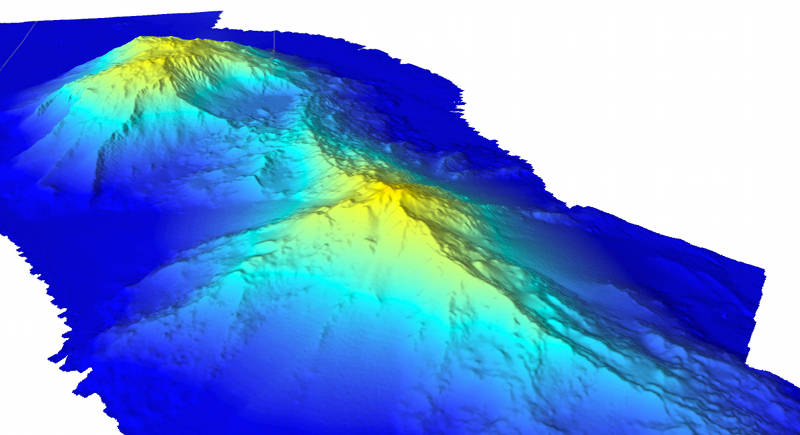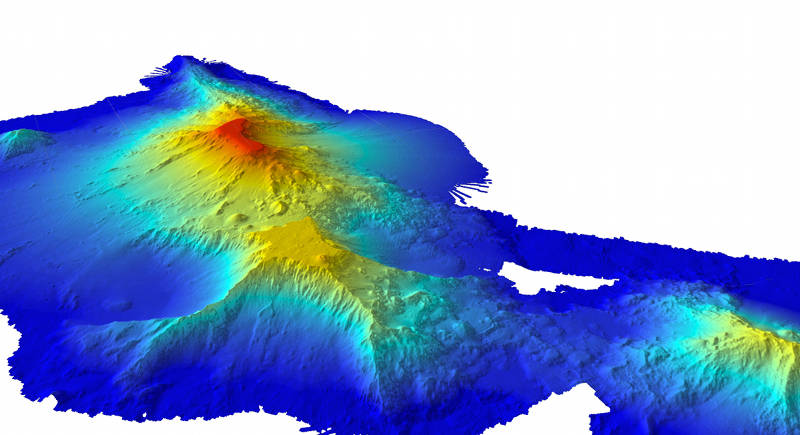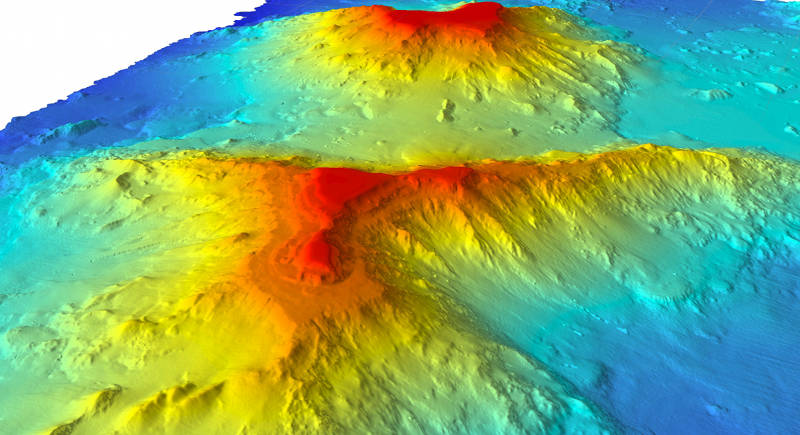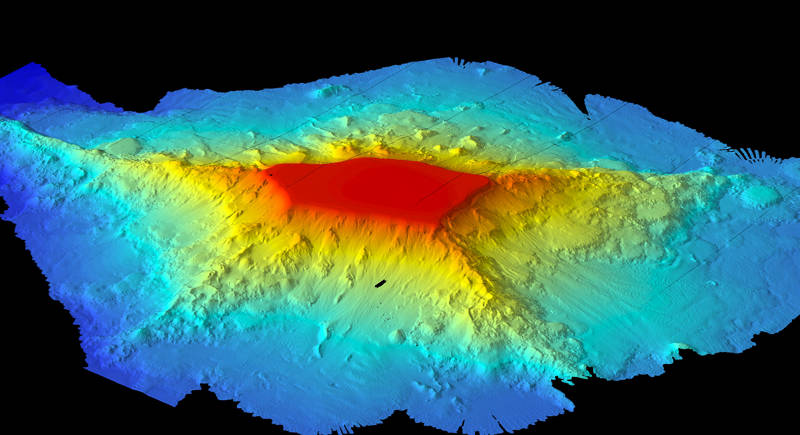
By Les Watling - Department of Biology, University of Hawaii at Mānoa

Two unnamed seamounts located southwest of Midway Atoll. Image created from data collected on the R/V Falkor in Spring 2014. Download larger version (jpg, 1.4 MB).
The deep seafloor, far from being a smooth muddy plain, is home to a large number of undersea mountains. By definition seamounts are geological structures more than 1,000 meters (3,300 feet) high, but most are much taller than that, rising from the seafloor at about 5,000 meters depth to within a few hundred meters of the ocean surface. Or, occasionally breaking the sea surface in which case they are then called islands.
It is difficult to know just how many seamounts there are, but they seem to be quite abundant. Using data from satellite altimetry and radar, as well as bathymetric data obtained from survey ships, estimates of the number of seamounts range from 14,700 to more than 33,000. This variation in the estimates is due to the different ways the bathymetric data are treated by the computer algorithms used.

A flat-topped seamount known only as Bank 9 that has two major terraces and therefore may be a composite of two separate seamounts of different ages. Image created from data collected on the R/V Falkor in Spring 2014. Download larger version (jpg, 1.7 MB).
The Pacific seems to have a very high number of seamounts that span a very broad range of ages. Some, such as those in the Northwestern Hawaiian Island chain, are relatively young, less than 5 million years old, whereas as others, including some just south of Hawaii, are more than 70 million years old. The oldest seafloor in the world (about 160 million years) is in the western Pacific, so it is possible there may be seamounts of about that age, but it’s not possible for there to be any seamounts that are older.
Most seamounts are of volcanic origin, and so when young, are usually regularly conical structures much like volcanos on land. As they age, however, they gradually sink deeper in the sea and become more irregular in shape. These changes are due to the fact that the seafloor under the seamount cools and shrinks, resulting in seamount subsidence (sinking) so that the summit of the seamount gradually moves deeper relative to the sea surface. Also, with time, some parts of the seamount fall away, creating large indentations in one or more sides and giving the seamount more of a star-shape.
Seamounts are known to harbor a wide diversity of life forms and are sometimes thought of as oases for life in the deep sea. This is because the surrounding seafloor is usually soft mud, and even though the muddy seafloor is home to a very high diversity of species, there are very few larger organisms and so it is looked at, erroneously, as a biological desert. Seamounts, on the other hand, intercept and often cause acceleration of the water flow and that promotes the growth of high numbers of organisms that sometimes are very large. Part of the increase in numbers of large organisms is the result of water flow bringing more food and partly due to the abundance of exposed rock ledge found on seamounts which is ideal for corals and sponges to settle on.
Corals and sponges are the dominant organisms found on seamounts. The corals can be scleractinians (“the hard corals”), which typically construct reefs in tropical waters, or gorgonians, more typically known as the sea fans from tropical reefs.

Academician Berg and Turnif seamounts in the northernmost extent of PMNM. Both are Hawaiian in origin with typical flat tops created when they were at the surface thousands of years ago. Image created from data collected on the R/V Falkor in Spring 2014. Download larger version (jpg, 2.1 MB).
On deep seamounts, however, the absence of light limits any group that rely on symbiotic zooxanthellae for meeting their energy needs, so there are only a few species of colonial hard corals. In contrast, the diversity of gorgonians can be striking. On most seamounts the gorgonians range in size and shape from small (10-20 centimeters) fans to large (approximately one meter high) bushes to enormous elongate and sometimes curled bamboo “whips.” These have been seen to be as much as five meters in height. One gorgonian, Iridogorgia magnispiralis, was seen on Twin Banks, in the Northwestern Hawaiian Islands, to be almost seven meters in height. It is the largest gorgonian ever seen.
Sponges seem to be almost as diverse as the corals. They range from small and encrusting to large shield-like forms or massive and sometimes foliose. A major group of sponges commonly found on seamounts, but that is absent or rare in shallow water, are the glass sponges, or hexactinellids. They have complex spicules in their skeleton and can often be very hard; when picked up, they can seem to be almost made of stone. Other glass sponges, especially the venus flower basket, are more delicate and their skeletons more intricate.

Ladd seamount in PMNM. Image created from data collected on the R/V Falkor in Spring 2014. Download larger version (jpg, 2.0 MB).
Both corals and sponges provide habitat for a large number of other species. Usually those are species who are collecting food particles from the passing water, so climbing onto a coral or sponge helps an organism get further above the bottom where water flow is better and particles are likely to be a bit more numerous.
Other species have formed tight associations with their host. One brittle star, for example, lives its entire life with its host gorgonian coral and somehow, no other brittle stars are allowed on the host. Another example is a marine worm which settles on the coral host when the worm is at the juvenile stage. It then induces the coral to change the morphology of the branches so that a tunnel is formed in which the worm lives. Also, a dumbo octopus routinely uses the axis of a few coral species as a place on which to attach its eggs, usually one or two per colony. There seem to be many associations like these but only a few have been studied in any detail. In the end, however, these associations raise the level of diversity of the species found on seamounts.
Seamount communities are most diverse and the corals and sponges are most abundant on the sides, especially on ridges, and along the margins of the summits. This pattern is due entirely to acceleration of water flow around and over the seamount. In general though, over all the seamounts that I have had the pleasure to dive on, either with a remotely operated vehicle or with submersibles, it is very rare to travel over any part of a seamount and not find a coral or sponge or some other living organism. Seamounts are truly oases in the sea and support an abundance of life.